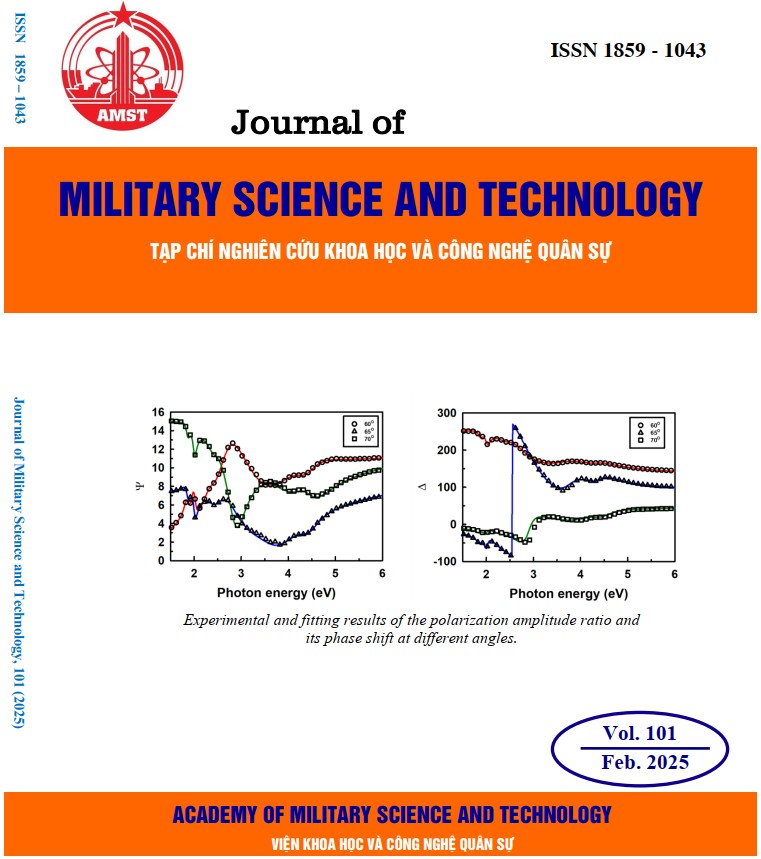Synthesis of MIL-101(Cr) metal-organic framework material and research photocatalytic capability of material for nitrate removal in water
614 viewsDOI:
https://doi.org/10.54939/1859-1043.j.mst.101.2025.102-109Keywords:
MOF; MIL-101; Nitrate removal efficiency; Hole scavenger.Abstract
This paper presents the research results on some characteristics of the metal-organic framework material MIL-101(Cr) and its ability to remove nitrate from aqueous environments based on photocatalytic reactions. This material was synthesized using the hydrothermal method in the laboratory. Techniques such as FE-SEM, XRD, FT-IR, and BET were employed, demonstrating that the porous structure of the material is highly developed, with a specific surface area of up to 3017 m²/g and characteristic octahedral crystal size ranging from approximately 100 to 300 nm. Experimental results show that under UV light conditions at a wavelength of 365 nm and a power of 250 W, the MOF MIL-101(Cr) can catalyze nitrate removal under UV light, achieving a maximum removal efficiency of up to 99% after 180 minutes of reaction. The nitrate removal efficiency of MIL-101 is significantly improved, and reaches nearly 100% within a reaction time of 40 minutes when formic acid (HCOOH 46 mM) is used as a hole scavenger.
References
[1]. E. Bowles, M. Burleigh, A. Mira, S. Van Breda, E. Weitzberg, and B. Rosier, "Nitrate:“the source makes the poison”," Crit. Rev. Food Sci. Nutr., 1-27, (2024). DOI: https://doi.org/10.1080/10408398.2024.2395488
[2]. F. Rezvani, M.-H. Sarrafzadeh, S. Ebrahimi, and H.-M. Oh, "Nitrate removal from drinking water with a focus on biological methods: a review," Environ. Sci. Pollut. Res. 26, 1124-1141, (2019). DOI: https://doi.org/10.1007/s11356-017-9185-0
[3]. A.P. Varghese, and S.K. Lakhera, "Comprehensive analysis of catalysts, reaction mechanisms, and efficiency factors in photocatalytic nitrate-to-ammonia conversion," Renew. Sustain. Energy Rev. 200, 114537, (2024). DOI: https://doi.org/10.1016/j.rser.2024.114537
[4]. S. He, L. Wu, X. Li, H. Sun, T. Xiong, J. Liu, C. Huang, H. Xu, H. Sun, and W. Chen, "Metal-organic frameworks for advanced drug delivery," Acta Pharm. Sin. B. 11, 2362-2395, (2021). DOI: https://doi.org/10.1016/j.apsb.2021.03.019
[5]. F. Zheng, W. Zhang, Q. Guo, B. Yu, D. Wang, W. Chen, "Metal clusters confined in porous nanostructures: Synthesis, properties and applications in energy catalysis," Coord. Chem. Rev. 502, 215603, (2024). DOI: https://doi.org/10.1016/j.ccr.2023.215603
[6]. Z. Wang, C. Wang, Q. Hu, X. Lei, R. Guo, J. You, Y. Tian, F. Yang, and M. Lv, "Covalent-metal organic frameworks: preparation and applications," Chem. Eng. J., 149217, (2024). DOI: https://doi.org/10.1016/j.cej.2024.149217
[7]. J. Cao, Y. Li, M. Qi, X. Ma, F. He, Y. Wang, and D. Zhao, "Engineering porosity of MIL-101 (Cr) using solvation effect," J. Environ. Chem. Eng. 12, 112753, (2024). DOI: https://doi.org/10.1016/j.jece.2024.112753
[8]. T.H. Dolla, B. Zhang, T. Matthews, M.P. Chabalala, S.O. Ajayi, L.L. Sikeyi, X. Liu, and M.K. Mathe, "Metal/covalent-organic framework-based electrocatalysts for electrochemical reduction of nitrate to ammonia," Coord. Chem. Rev. 518, 216061, (2024). DOI: https://doi.org/10.1016/j.ccr.2024.216061
[9]. X. Yang, X. Qi, G. Ma, Z. Li, Q. Liu, S. Khan, Y. Zhao, L. Zhang, Z. Geng, and Y. Guo, "Novel Z-Scheme Ag/TiO2/AgMIL-101 (Cr) as an efficient photocatalyst for nitrogen production from nitrate," Appl. Surf. Sci. 479, 1048-1056, (2019). DOI: https://doi.org/10.1016/j.apsusc.2019.02.111
[10]. A. Augustin, P. Ganguly, S. Shenoy, C. Chuaicham, S.C. Pillai, K. Sasaki, A.F. Lee, and K. Sekar, "Impact of hole scavengers on efficient photocatalytic hydrogen production," Adv. Sustain. Syst., 2400321, (2024). DOI: https://doi.org/10.1002/adsu.202400321
[11]. J. A. Zazo, P. García-Muñoz, G. Pliego, J. E. Silveira, P. Jaffe, and J. A. Casas, "Selective reduction of nitrate to N2 using ilmenite as a low cost photo-catalyst," Appl. Catal. B. 273, 118930, (2020). DOI: https://doi.org/10.1016/j.apcatb.2020.118930
[12]. J. Xie, R. Wang, Z. Ni, Y. Li, S. Ye, and X. Song, "The visible light photocatalytic degradation of ethylene using a polyvinyl alcohol film loaded with Ag2O-TiO2-Bi2WO6 heterojunction microspheres," Appl. Surf. Sci. 584, 152562, (2022). DOI: https://doi.org/10.1016/j.apsusc.2022.152562
[13]. N. Cherupurakal, R. Krishnapriya, A. Bojarajan, T. Ramachandran, S. Sangaraju, M.S. Mozumder, and A.-H.I. Mourad, "Enhanced electrochemical validation of metal organic frameworks-derived TiO2/Fe-TiO2 as an active electrode for supercapacitors," Mater. Renew. Sustain. Energy. 1-13, (2024). DOI: https://doi.org/10.1007/s40243-024-00269-4
[14]. Z. Geng, Z. Chen, Z. Li, X. Qi, X. Yang, W. Fan, Y. Guo, L. Zhang, and M.J.D.T. Huo, "Enhanced photocatalytic conversion and selectivity of nitrate reduction to nitrogen over AgCl/TiO2 nanotubes," 47, 11104-11112, (2018). DOI: https://doi.org/10.1039/C8DT01915K
[15]. R. Wang, M. Yue, R. Cong, W. Gao, T.J.J.o.A. Yang, and Compounds, "Photocatalytic reduction of nitrate over chalcopyrite CuFe0.7Cr0.3S2 with high N2 selectivity," 651, 731-736, (2015). DOI: https://doi.org/10.1016/j.jallcom.2015.08.182
[16]. H. Adamu, M. Shand, R.S. Taylor, H.G. Manyar, and J.A. Anderson, "Use of carbon-based composites to enhance performance of TiO2 for the simultaneous removal of nitrates and organics from aqueous environments," Environ Sci Pollut Res Int. 25, 32001-32014, (2018). DOI: https://doi.org/10.1007/s11356-018-3120-x







